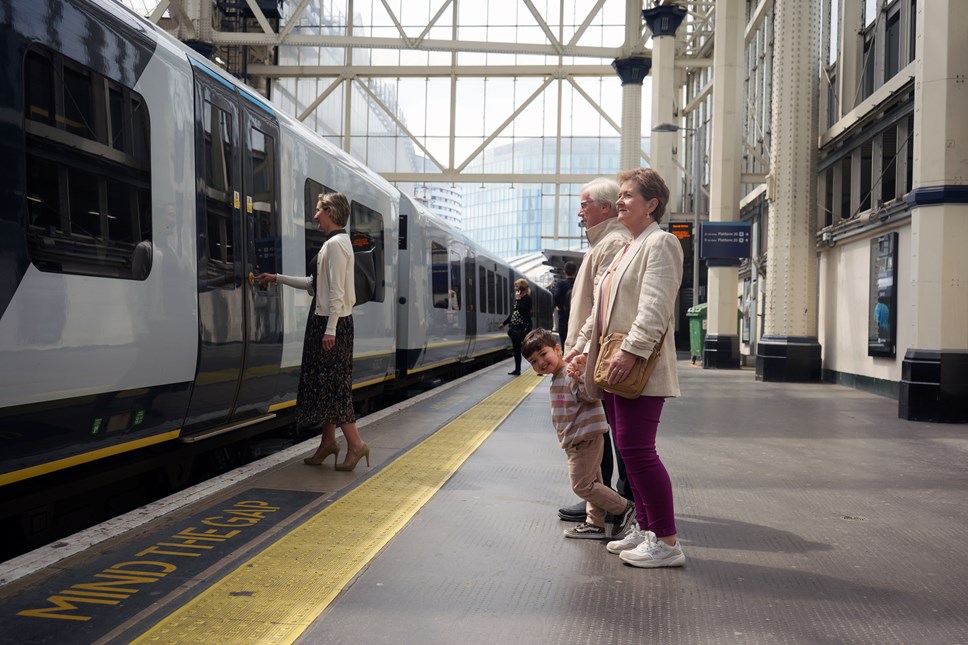
Rail commuting up 8% as strikes impact reduces
- Commuting grew 8% during the first three months of this year, boosting railway revenue to the tune of £64 million – according to the latest GBRTT Train Travel Snapshot.
- Fewer strike days disrupted services after the first week of the new year, which helped the quarter-on-quarter comparison*.
- This pushed revenue to a record high since the start of the pandemic (£2.2 billion) – but GBRTT warns that, adjusting for inflation, this is just 70% of revenue (£3.2 billion) four years ago, with the inclusion of Elizabeth line figures also affecting historic comparisons**.
Fresh analysis published today (8 June) by Great British Railways Transition Team (GBRTT) unpicks the reasons people are taking the train, as well as implications and opportunities for industry revenue.
Leisure travel has historically been the largest market (£1.2 billion), but has grown as a share of overall revenue compared to pre-pandemic and weekend demand in particular is up a fifth (22%). The number of leisure journeys took a natural post-Christmas dip this quarter.
GBRTT’s Train Travel Snapshot (1 January - 31 March 2023)
|
Journey purpose |
Revenue |
Revenue change from last quarter |
Number of journeys |
|
Business |
£177 million |
-£3 million (-2%) |
25 million |
|
Commute |
£851 million |
+£64 million (+8%) |
173 million |
|
Leisure |
£1,175 million |
+£27 million (+2%) |
190 million |
Figures released just hours earlier by the Office of Rail and Road showed total revenue (£2.2 billion) was up 4% compared to the previous quarter. The industry hit another milestone in mid-March, with weekly revenue climbing above £190 million for the first time since pre-pandemic.
This was aided by the reduced disruption from industrial action and the first full quarter of a fully joined-up Elizabeth line***. A resolution to the Network Rail dispute is likely to have increased travellers’ confidence in making plans to travel by train.
Suzanne Donnelly, Director of Passenger Revenue at GBRTT, said: “Commuting was the success story this quarter as strike disruption receded. Millions more trips will have boosted not only rail revenue but cafés, pubs and restaurants in our cities and towns.
“We should be cautious when interpreting overall industry recovery figures. Inflation and the opening of the Elizabeth line, mean we’re not comparing apples with apples when we look back to 2019. Railway revenue is still falling short, contributing to a sizeable gap in industry finances.
“However we believe there’s plenty more growth to go for in all three markets. That’s important because rail is a great green option, helping to unclog roads and boost productivity. To entice customers, we've kicked off a fresh burst of the national marketing campaign Nothing Beats Being There, we’re working on simpler fares and a better, more consistent customer experience - all of which will be underpinned by a responsive, accountable Great British Railways.”
Our LinkedIn post
Notes to editors
Notes to Editors
* There were 9 days of national industrial action in this quarter, compared to 12 in the last. However, these national strike days (5 out of 9) were largely concentrated in the first week of the quarter.
** This new railway has changed travel patterns in and around London, including some switching of travel from London Underground (TfL) and Docklands Light Railway (DLR) to Elizabeth Line which is included in National Rail figures. To illustrate the impact on historic comparability, national passenger journeys in the latest quarter (January to March 2023) were 88% of the same quarter four years ago (pre-pandemic), however if the Elizabeth line is excluded from the comparison this reduces to 73%. The ORR is also working with RDG and TfL to correct a technical issue in LENNON which has resulted in overestimates for Elizabeth line passenger journeys affecting national totals, although revenue is unaffected. For more information about the impact of the Elizabeth line, please refer to the ORR’s latest Passenger Rail Usage report.
*** The second stage of opening the new Elizabeth line (Reading, Heathrow, and Shenfield connecting directly to central London) happened mid-way through the last quarter, in November, which also affected the quarter-on-quarter comparison.
Previous editions
The first GBRTT Train Travel Snapshot can be found on Great British Transition Team’s website.
GBRTT’s Train Travel Snapshot Methodology
National industry revenue and journeys figures are taken from those published by ORR each quarter. These figures and the methodology used to infer them can be found on the Passenger Rail Usage page of ORR’s data portal.
Data from the Wavelength survey has been used by GBRTT’s Passenger Revenue team to infer an estimated split of revenue and journeys by market for each quarter. These proportions have been applied to the overall ORR revenue and journeys figures. All revenue data is presented in January to March 2023 prices.
The statistics for 2022-23 Quarter 4 (1 January 2023 to 31 March 2023) were published by ORR on 8 June 2023, and so the figures presented in this report represent the latest available data.
The definition of business, leisure and commuter travellers is based on responses from the Wavelength survey:
- A business traveller is someone who is travelling on company business, i.e. for a work meeting
- A commuter is someone who is travelling to or from their usual place of work or education
Leisure passengers include those travelling for personal leisure reasons (e.g. visiting friends or family, days out, shopping, entertainment, sports activities, etc) plus people travelling for personal business reasons (e.g. a health appointment, a job interview or other appointment).

